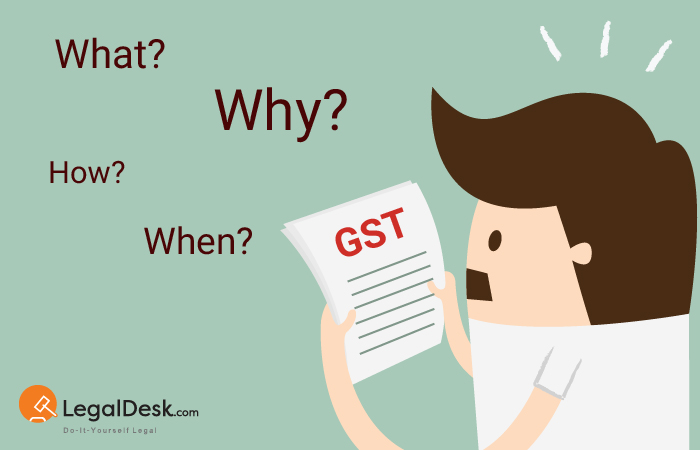What Is GST And Why GST?
We all have been hearing about GST for the past few years. 2017 is the year we see it all (right from the proposal of the GST Bill till its implementation through GST law) come to fruition. GST is the taxation system proposed to replace all existing taxes by encompassing these taxes into a single and comprehensive Goods and Service Tax. Sometimes referred to as VAT and HST, we have seen several countries (Canada, Singapore, Australia, France, UK, New Zealand, Malaysia, etc.) successfully implement some form of GST over the past few decades. Most of these countries have GST rates between 5% – 20%. Just as India is doing now, Canada had adopted a dual GST model as well.
GST is an indirect tax levied on the sale, manufacture and consumption of goods and services throughout a country. Under the proposed GST regime in India, the tax is paid by the final consumer on the supply of goods and/or services. A person has to pay tax once they cross the threshold limit of INR 10 Lacs (5 Lacs for the North-Eastern States). In some cases, a person will be required to pay GST even if he or she hasn’t crossed the threshold limit.
How Will GST Impact An Average Person?
GST has been covered from various angles, but it is important to look at who GST is going to affect the most. Us! The consumer, the average person, the taxpayer. Let’s take a look at some of the realistic advantages and disadvantages GST will have:
- GST is a tax on the value addition on goods and services to be borne by the final consumer, that is the common man. According to Government estimates, the biggest benefit of GST for the average citizen is a reduction in the overall tax burden on goods. The current rate of tax on goods is between 25% – 30%.
- Small taxpayers with an aggregate income of under INR 10 Lacs in a financial year would be exempt from paying GST. The threshold for the N.E States and Sikkim is INR 5 Lacs in an FY. This is a big boost to small and medium-scale enterprises in India. Taxpayers that make interstate supplies or paying taxes on a reverse charge basis are not eligible for the aforementioned exemption.
- For most goods, the rate of indirect tax levied is pretty high. This means that we as consumers end up spending more on goods and services such as consumer electronics, beauty products, non-luxury automobiles, etc. by way of excise duty (12.5%) and VAT (12.5% – 15% depending on the State). Sometimes customers also pay multiple taxes or cascading taxes at each stage and that’s one hefty tax charge to be paid by the time the good or service has reached the end customer.
- The rate of tax on certain goods and services (edible oil, textiles, low-value footwear, etc.) will increase as well with the advent of GST {previously, excise duty was nil and the States charged a 5% VAT}. The proposed GST slab will cause the tax rates for these goods and services to be higher for the final consumer.
- GST is easier to administer and understand for the common man and for Government appointed officials. It removes the multiplicity of taxes compounded through several different taxes levied by the Center and the State by combining all previous taxes into a single Goods and Service Tax or GST.
- GST will make products competitive in the domestic and international market. This means that we, as citizens would get competitively goods and services of high quality and standard at a cheaper rate. This would increase public spending spurring an economic growth.
- All smokers take note. Tobacco and tobacco- related products would be subject to GST taxation. Additionally, the Central Government has the power to central excise duty on tobacco and tobacco-related products.
- It is important to note that the following goods and commodities will not fall under the purview of GST are:
- Alcohol for human consumption
- Petrol and petroleum products (motor spirit, crude petrol, etc.)
- High-speed diesel
- Aviation turbine fuel
- Natural gas
- Electricity
GSTN
The Goods and Services Tax Network is a non-profit body appointed to create a platform (portal) for the stakeholders of GST to collaborate on. There is a facility for using digital signatures or eSign for the GSTN registration process.
GST Registration In India
A person must take registration within 30 days from the date on which he becomes liable to registration. If a person has multiple business operations across different States, then that individual must register for GST separately for each of those States.
As per Schedule III of MGL, GST registration is required compulsorily by –
- Individuals making any inter-state taxable supply
- Casual taxable persons
- Individuals who are required to pay tax under reverse charge
- Non-resident taxable persons
- Individuals who are required to deduct tax under section 37
- Individuals who supply goods and/or services on behalf of other registered taxable persons either as an agent or otherwise
- Input service distributor
- Persons who supply goods and/or services, other than branded services, through electronic commerce operator
- Every electronic commerce operator
- An aggregator who supplies services under his brand name or his trade name
- Such other person or class of persons as may be notified by the Central Government or a State Government on the recommendations of the Council
Note: An agriculturalist shall not be considered as a taxable person and will not be required to register for GST.
GST Rates (item-wise)
The GST rate structure is described below:
| Sr. No. | Items | GST Rate |
| 1 | Spices, tea | 5% |
| 2 | Mustard Oil | 5% |
| 3 | Processed Foods | 12% |
| 4 | Soaps | 18% |
| 5 | Oil | 18% |
| 6 | Toothpaste | 18% |
| 7 | Refrigerators | 18% |
| 8 | Smartphones | 18% |
| 9 | White Goods | 28% |
| 10 | Cars | 28% |
| 11 | Luxury cars | 28% + cess |
| 12 | Pan masala | 28% + cess |
| 13 | Tobacco | 28% + cess |
| 14 | Aerated drinks | 28% + cess |
Certain items are exempted from GST which include bread, eggs, milk, non-mineral water, fruits (by the State), coarse fabric, grains, poha, cereals, salt, vegetables, books and so on.
GST Updates (2017)
The top 5 GST updates are:
- The chairman of the CBEC has stated that GST rates have to factor in Vat Rates, Central Excise Rates and Area-Based Exemptions.
- The Finance Minister, Mr.Arun Jaitley said that GST Council is to meet to decide on taxation structures & rates by May.
- The Finance Minister had hoped the GST council will approve the rules by 31st March and added that the GST Council is following a logical mathematical formula for formulating the GST rates.
- GST rates are being fixed in such a way that it doesn’t lead to consumer price inflation.
- Industry experts believe that if rates are revealed earlier, some companies may indulge in activities related to tax avoidance.
The Outcome Of GST
As for more than 95% of the population, GST signifies a benefit in the long-run. The prices of certain goods and services will rise, while the prices of others will fall, which will directly affect us. Though GST would enable our country to have a single national market, a better tax structure, easier administration and enforcement, etc. there will be certain hurdles along the way such as the initial implementation period concerns and settling on a tax rate/slab and more. But the other added advantages with the implementation of GST outweigh the cons and hence, logically, GST is essential for our Nation’s best interest.


